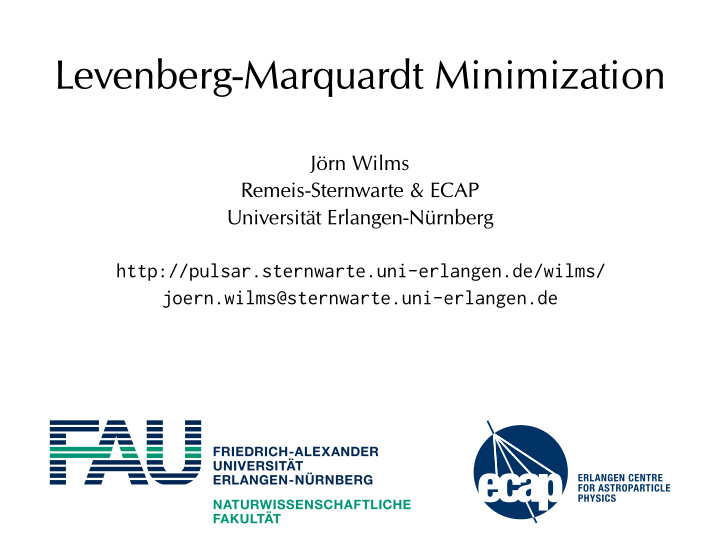



Levenberg-Marquardt Minimization Jörn Wilms Remeis-Sternwarte & ECAP Universität Erlangen-Nürnberg http://pulsar.sternwarte.uni-erlangen.de/wilms/ joern.wilms@sternwarte.uni-erlangen.de
Introduction The fitting problem: • Given the linear model n ch � N ph, predicted ( c ; ρ ) = ∆T · A ( E i ) · R ( c , i ) · M ( E i ; ρ ) · ∆E i + N background ( c ) i = 0 ∀ c ∈ { 1, 2, . . . , n en } (1) where M ( E i ; ρ ) is the spectral model, which depends on parameters x , and • given a fit statistics S 2 ( x ) = f � � N ph, measured , N ph, predicted ( x ) (2) what is the x of the “most likely” mode. ⇒ Minimization problem =
Minimization Methods Take the residual vector at a value x : R = computed − observed (3) σ Change as one varies x : J = dR β = J T R where (4) d x J: Jacobi matrix. Change parameters by ∆ x = − α − 1 β (5) where the curvature matrix is α = J T J (6) Then iterate until convergence.
Levenberg-Marquardt Levenberg-Marquardt-method (LM-Method): Numerical method to mini- mize fit statistics Levenberg, 1944, Q. Appl. Math 2, 164, Marquardt, 1963, SIAM J. Appl. Math. 11, 431 Modify simple gradient minimization by damping: Replace α with α ′ where � α jj ( 1 + λ ) multiplicative damping α ′ jj = (7) α jj + λ additive damping i.e., the damped curvature matrix is (add. damping): (8) α + λ ✶ LM: adjust λ : Initially: want α ∼ gradient, to lie in direction of steepest de- scent. for additive damping: shrinks ∆p = ⇒ stablizing iteration by preconditioning the matrix α ; in contrast, multiplicative damping will help the method against badly scaled problems
Levenberg-Marquardt LM algorithm: decide how to change λ between steps: Depending on how sum of squares (SOS) behaves at x + ∆ x : • SOS decreased: λ ′ = λ · DROP • SOS increased: drop p ′ , set λ ′ = λ · BOOST Note: 1. Assumes sum of squares-like likelihood ML won’t work well on C-stat!! 2. Efficiency depends on values of BOOST and DROP. Lampton (1997, Computers in Physics 11, 110): additive, DROP = 0.1, BOOST = 1.5 is well behaved, but not always XSPEC does not allow changing these parameters, ISIS does
Recommend
More recommend